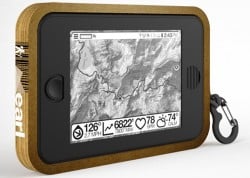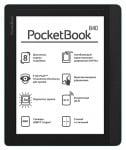The Digital Reader |
- Malware-Infested Ads Now a Threat When Reading Online
- Earl E-ink Android Tablet Delayed Until 2015
- Pocketbook InkPad 8″ eReader Now (Reportedly) Shipping
| Malware-Infested Ads Now a Threat When Reading Online Posted: 26 Oct 2014 04:03 PM PDT
That doesn’t stop some experts like Benedict Evans from calling such plugins “malware installed by the user“, but a new report from security researchers should take the wind out of his sails. A team of security researchers at Proofpoint have reported that they have identified a “malvertisng” campaign which used ads displayed on high traffic sites to infect the computers of anyone who visited the site. What’s malvertising?
Proofpoint reports that they subsequently worked quickly to inform the affected parties who then took steps to remove the ads. The last malicious ad was detected on 18 October. Or rather, the last sign of that campaign was detected last week; it’s certainly not going to be the last malicious ad ever, which means that users will still need to protect themselves. It’s pretty clear no one else is going to be able to:
To put it simply, an ad blocker isn’t a sign of selfishness anymore; it’s now part of the basic security steps you should take when browsing online. I know that’s going to upset anyone who relies on advertising (I don’t like it) but that doesn’t change the fact that this won’t be the mast malvertisng campaign. Until the online ad industry gets better at preventing malicious ads, people have to protect themselves, and that means blocking ads. images by IntelFreePress, Robbert van der Steeg The post Malware-Infested Ads Now a Threat When Reading Online appeared first on The Digital Reader. |
| Earl E-ink Android Tablet Delayed Until 2015 Posted: 26 Oct 2014 11:57 AM PDT
A new update on the Earl was posted last week on the Sqigle website, saying in part that:
This latest delay will likely push the delivery date back until next year, if not later. The Earl was designed to be a drop, impact, water, and dust resistant Android tablet based around a 6″ E-ink screen. These stringent requirements have led to several major redesigns since the Earl was first announced in May 2013, each of which has pushed back the Earl’s release date by several months.
According to the specs, the Earl runs Android 4.4 KitKat on a dual-core 1GHz Freescale CPU with 1GB RAM, 16GB internal storage, Wifi, Bluetooth, NFC, GPS, and multiple sensors. It is going to use a 6″ Mobius E-ink screen with a glove friendly touchscreen. It was originally funded as part of a crowd-funding campaign in May 2013. Early supporters bought their place in line for $249, but after the campaign closed the price was bumped to $299. If you feel like gambling, the Earl is still listed for pre-order for $299. I’ve never been so inclined. When the Earl was first announced I was short of funds, and then after it met its first roadblock I counted myself lucky to have avoided investing in a project which I didn’t think would succeed. And I’m still not convinced that the Earl will ship, but even if it foes I have lost interest. My main interest in the Earl was less its ruggedness and outdoorsy-ness than the fact it ran Android on E-ink. When the Earl was announced in May 2013, there weren’t any good options for Android on E-ink. Your only real options were some ereaders like the Nook Touch and the Sony Reader PRS-T2 which could be hacked to bypass the original software limitations. Now there are several options for Android ereaders, including the Onyx T68 Lynx, Icarus Illumina, and the Boyue T62. They’re not nearly up to the abilities of the Earl, but on the plus side they are readily available – and the Earl is not. The post Earl E-ink Android Tablet Delayed Until 2015 appeared first on The Digital Reader. |
| Pocketbook InkPad 8″ eReader Now (Reportedly) Shipping Posted: 26 Oct 2014 08:21 AM PDT
And now it is finally shipping (I hope). Pocketbook France informs me that they have started shipping the InkPad 840 to customers. (I’m still waiting on a tracking number for my unit, but that is what they have reported.) The InkPad caught my eye when it launched in May because it had an unusual screen size and an unusual screen resolution. The InkPad’s 8″ display has a screen resolution of 1,200 x 1,600, giving it a sharpness of 250ppi. That’s not as sharp as on the 6.8″ screen used by the Onyx T68 Lynx and Kobo Aura H2O, or the screen on the new Voyage, but the InkPad’s screen is also larger – a detail which I am sure is appreciated by PDF users .
Like other PocketBook ereaders, it ships with support for a wide variety of ebook formats, including Epub, PDF, and Kindle (drm-free). Not all of those formats are well-supported, though, so I would not count on the InkPad as a multi-format device (this is one thing I learned from my review of the Pocketbook Ultra 650.) The InkPad also ships with a number of apps, including a web browser, file manager, calculator, several games (klondike, chess, sudoku), notpad, sketchpad, Dropbox, mp3 player, and others. I’ve been wanting to buy an InkPad ever since it launched this summer, and I’ve been waiting for Pocketbook France to ship my order since early September. If and when it does arrive, I will be posting a review. Until then, here are a trio of hands on videos which show the InkPad in relation to other ereaders and how it will look in a user’s hands. The post Pocketbook InkPad 8″ eReader Now (Reportedly) Shipping appeared first on The Digital Reader. |
| You are subscribed to email updates from The Digital Reader To stop receiving these emails, you may unsubscribe now. | Email delivery powered by Google |
| Google Inc., 1600 Amphitheatre Parkway, Mountain View, CA 94043, United States | |
![7853146846_4cc5d03168_o[1]](http://the-digital-reader.com/wp-content/uploads/2014/10/7853146846_4cc5d03168_o1-250x167.jpg)
![8280822928_96f83c9e86[1]](http://the-digital-reader.com/wp-content/uploads/2014/10/8280822928_96f83c9e861-250x231.jpg)

![july4[1]](http://the-digital-reader.com/wp-content/uploads/2014/10/july41-250x250.jpg)
 Pocketbook’s
Pocketbook’s
No comments:
Post a Comment